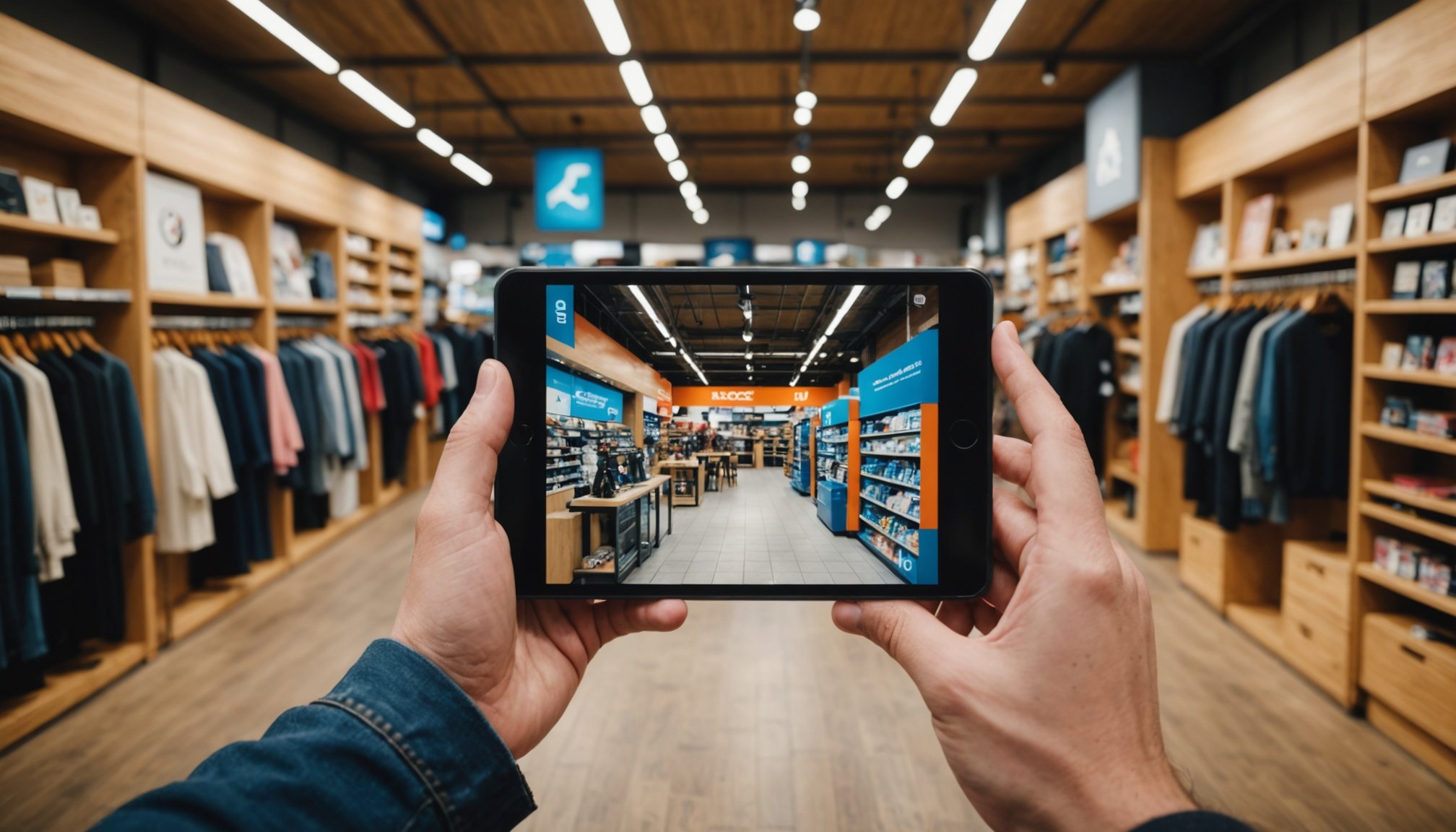Unlocking Retail Success: Innovative Augmented Reality Tactics for UK Shops
In the ever-evolving retail landscape, technology is playing an increasingly crucial role in enhancing customer experiences and driving business success. One of the most promising technologies in this realm is augmented reality (AR), which is transforming the way UK shops engage with their customers and present their products. Here’s a deep dive into how AR is revolutionizing the retail sector and what retailers can do to leverage this technology.
The Rise of Augmented Reality in Retail
Augmented reality is no longer a novelty but a necessity for retailers looking to stay ahead of the curve. This technology combines the physical and digital worlds, providing customers with immersive and interactive shopping experiences.
Also read : Revitalizing UK Non-Profits: Breakthrough Crowdsourcing Strategies for Effective Fundraising
Why AR is Becoming Essential
Retailers are embracing AR for several compelling reasons:
-
Enhanced Customer Engagement: AR allows customers to interact with products in a more engaging and personal way. For instance, using AR, customers can virtually try on clothes, see how furniture would look in their home, or explore the features of a product in real-time[2][4].
In the same genre : Profit Boost: Harnessing Data Insights for Optimal Menu Pricing at UK Restaurants
-
Increased Transparency: With AR, retailers can provide detailed information about products, such as origins, ingredients, and environmental impact. This transparency is crucial as 77% of consumers consider product information important when making purchases[1].
-
Competitive Edge: In a crowded market, AR offers a unique selling proposition. Retailers like Ben & Jerry’s and Jackson Family Wines have already seen significant increases in engagement and sales by using AR to tell their brand stories[2].
How Retailers Are Using Augmented Reality
Retailers are innovatively integrating AR into various aspects of their business to enhance the shopping experience.
Virtual Try-Ons and Product Demonstrations
One of the most popular uses of AR in retail is the virtual try-on feature. This allows customers to see how a product would look without the need for physical trials. For example, in the cosmetics sector, AR enables customers to virtually try on makeup, reducing the need for in-store testers and enhancing the overall shopping experience[4].
| Feature | Benefits | Examples |
|---|---|---|
| Virtual Try-Ons | Reduces returns, enhances customer satisfaction | Sephora, IKEA |
| Product Demonstrations | Provides detailed product information, increases engagement | Home Depot, Lowe’s |
| Interactive Catalogs | Offers immersive product browsing, increases sales | IKEA, Wayfair |
Immersive Shopping Experiences
Retailers are also using AR to create immersive shopping experiences that blend the online and offline worlds. Virtual showrooms, for instance, allow customers to explore products in a fully digital environment. Dior’s virtual Parisian boutique is a prime example, where customers can explore the brand’s heritage and craftsmanship from anywhere in the world[3].
Enhanced Customer Service
AR is not just about product presentation; it also enhances customer service. Retailers can use AR to provide step-by-step instructions for product assembly or troubleshooting, improving the overall customer experience. For example, Intel used AR to demonstrate how their AI technology could improve anomaly detection in manufacturing, showcasing the practical application of AR in real-world scenarios[2].
The Role of QR Codes in Augmented Reality Retail
QR codes are becoming a critical component in the integration of AR in retail. These smart codes can carry vast amounts of information and provide customers with instant access to detailed product data.
Why QR Codes Are Replacing Barcodes
-
Increased Information Capacity: Unlike traditional barcodes, QR codes can store a significant amount of data, including product origins, ingredients, and environmental impact[1].
-
Real-Time Information: QR codes can link to online sources, providing real-time information about products. This is particularly useful for climate-conscious shoppers who want to know the carbon footprint of a product[1].
-
Global Adoption: Retail giants like Walmart, PepsiCo, and Amazon are already piloting QR codes across 48 countries, with a target for global rollout by 2027. This widespread adoption underscores the potential of QR codes in revolutionizing retail[1].
Meeting Consumer Demand for Transparency
Consumers are increasingly demanding more detailed information about the products they buy. Here’s how AR and QR codes are meeting this demand:
Detailed Product Information
-
Nutrition and Ingredients: QR codes can reveal detailed nutrition facts and ingredient lists, which is crucial for health-conscious consumers[1].
-
Sustainability and Ethical Practices: Consumers can access information about the environmental impact and labour standards associated with a product, aligning with their ethical and sustainability preferences[1].
-
Country of Origin: QR codes can provide information about where the product was made, which is important for consumers who prefer to support local or specific international producers[1].
Consumer Preferences
A recent survey highlighted the following consumer preferences:
- 77% of consumers consider product information important when making purchases.
- 62% are willing to spend more on products with detailed information.
- 79% prefer products with scannable QR codes providing additional details[1].
A Wider Shift in Retail Technology
The adoption of AR and QR codes is part of a broader technological shift in the retail sector.
Digital Transformation
The pandemic accelerated digitization across the retail sector, with brands embracing technologies like artificial intelligence, mobile technology, and immersive experiences to improve customer engagement. Self-checkout systems, mobile pay-and-go, and app-based navigation are becoming commonplace[1].
Integration of Immersive Technologies
One-third of retail executives believe that augmented and virtual reality will become central to shopping experiences by 2030. This integration of immersive technologies is expected to blend online and offline interactions, creating a seamless shopping experience[1].
Sustainability Focus
Over one-third of executives say that meeting sustainability goals will require significant investment in retail technology, including QR codes. These codes can help reduce paper and packaging waste, improve recycling behaviors, and accurately measure companies’ progress toward climate commitments[1].
Practical Insights and Actionable Advice for Retailers
For retailers looking to leverage AR and QR codes, here are some practical insights and actionable advice:
Start Small
Begin by integrating QR codes into your existing product labeling. This can provide immediate benefits in terms of customer engagement and transparency without requiring a full-scale overhaul of your systems[1].
Invest in WebAR
WebAR works on nearly all devices without requiring downloads, making it an accessible and user-friendly option for customers. This can be particularly effective for eCommerce platforms where customers can interact with products virtually[2][4].
Focus on Customer Experience
Use AR to enhance the customer experience by providing interactive and immersive experiences. For example, virtual try-ons and product demonstrations can significantly improve customer satisfaction and reduce returns[4].
Collaborate with Experts
Partner with companies specializing in AR and XR technologies to develop customized solutions that align with your brand’s needs. Rock Paper Reality, for instance, has helped several brands create innovative AR experiences that drive engagement and sales[2].
The Future of Retail Transparency
As the retail sector continues to evolve, transparency and customer engagement will remain at the forefront.
Consumer-Driven Change
Consumers are driving this change with their hunger for transparency and immersive experiences. As Kate Hardcastle, a retail strategist, puts it: “The retail message to consumers used to be ‘Stack it high, sell it cheap, open the doors and you may come in and buy.’ Now the consumer is the messenger: ‘This is what I want, how I want it and when I want it, and you, retailer, will deliver it.’”[1].
Gradual Transition
The transition to fully replace barcodes with QR codes will be gradual. By 2027, the industry expects to scan 2D barcodes at checkouts, but traditional barcodes may still appear alongside QR codes during this period of adjustment[1].
Augmented reality and QR codes are not just trends but essential tools for retailers aiming to thrive in the modern retail landscape. By providing detailed product information, enhancing customer engagement, and offering immersive shopping experiences, these technologies are set to redefine the retail sector.
As Anne Godfrey, CEO of GS1 UK, notes: “The next generation of barcodes – QR codes powered by GS1 – will underpin the next retail revolution to give greater power to the consumer.”[1].
For UK shops, embracing AR and QR codes is not just about keeping up with technology; it’s about delivering what customers want – transparency, engagement, and a seamless shopping experience. Whether you’re a small boutique or a retail giant, the time to invest in these innovative technologies is now.











